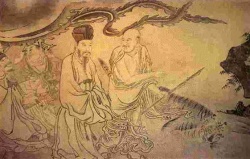Guanxiu
Guanxiu (Chinese: 貫休; pinyin: Guànxiū) was a celebrated Buddhist monk, painter, poet, and calligrapher. His greatest works date from the Five Dynasties and Ten Kingdoms Period. The collapse of the central Tang government in 907, meant artists and craftsmen lost their most powerful patrons. The imperial tang court had inspired a golden age of literature and art at its apogee. The various provincial courts who claimed to represent a continuation of the tradition of Tang government also claimed continuity in the arts and culture. The state of the Former Shu had acted as the traditional western sanctuary ever since the Emperor Xuanzong had sought refuge there during the An Shi Rebellion in 755. By the collapse of the Tang Dynasty something like a miniature Tang court existed at Chengdu. Guanxiu arrived in chengdu in 901, and remained there until his death.
The Wang Jian, the founding emperor of the Former Shu, bestowed upon him the honorific title Great Master of the Chan Moon (Chanyue dashi), however he is still known by his monk's name Guanxiu, which means "a string of blessings". He is famed for his depiction of arhats, disciples of historical Buddha, who lived harsh ascetic lives. He is however also known for his works in poetry and calligraphy as well; extroardinarily extant works exist for all three forms.
After Guanxiu's death, Shi Ke rose to prominence as Chan painter.
In particular Guanxiu is known for his depiction of the arhats particular to Chinese Buddhism. Chinese artists had been depicting them with great expressiveness and power since the since the sixth century, however Guanxiu's interpretations are often seen to have captured another dimension. A set of sixteen arhats is preserved in the Japanese Imperial Household Collection. This collection bears an inscription dated to 894. It states Guanxiu began the set while living in Lanxi, Zhejiang province.
The Chan Buddhist tradition of painting sought to express the immediacy and intensity of the artists intuition as well as to record moments of truth in the form of Buddhas or arhats. Even by the end of the Tang Dynasty Chan painters were practicing wildly eccentric works, which unfortunately have only survived through contemporary descriptions. His depiction of the arhats exhibit an exaggeration of features that borders on perversity, this style is typically Chan. The paintings display an emphasis on the arhat's skeletal bodies, and bony faces, as well as the incredible age of the sages.
According to Max Loehr, Guanxiu's arhats represent the physical embodiment of Buddhist persecution in eighth-century China. This persecution nearly obliterated the Buddhist establishment. The tormented faces are depicted as if the arhats themselves were survivors of the death and destruction. In Chinese painting the themes of pain, suffering, and death are depicted rarely outside of Buddhist art.
